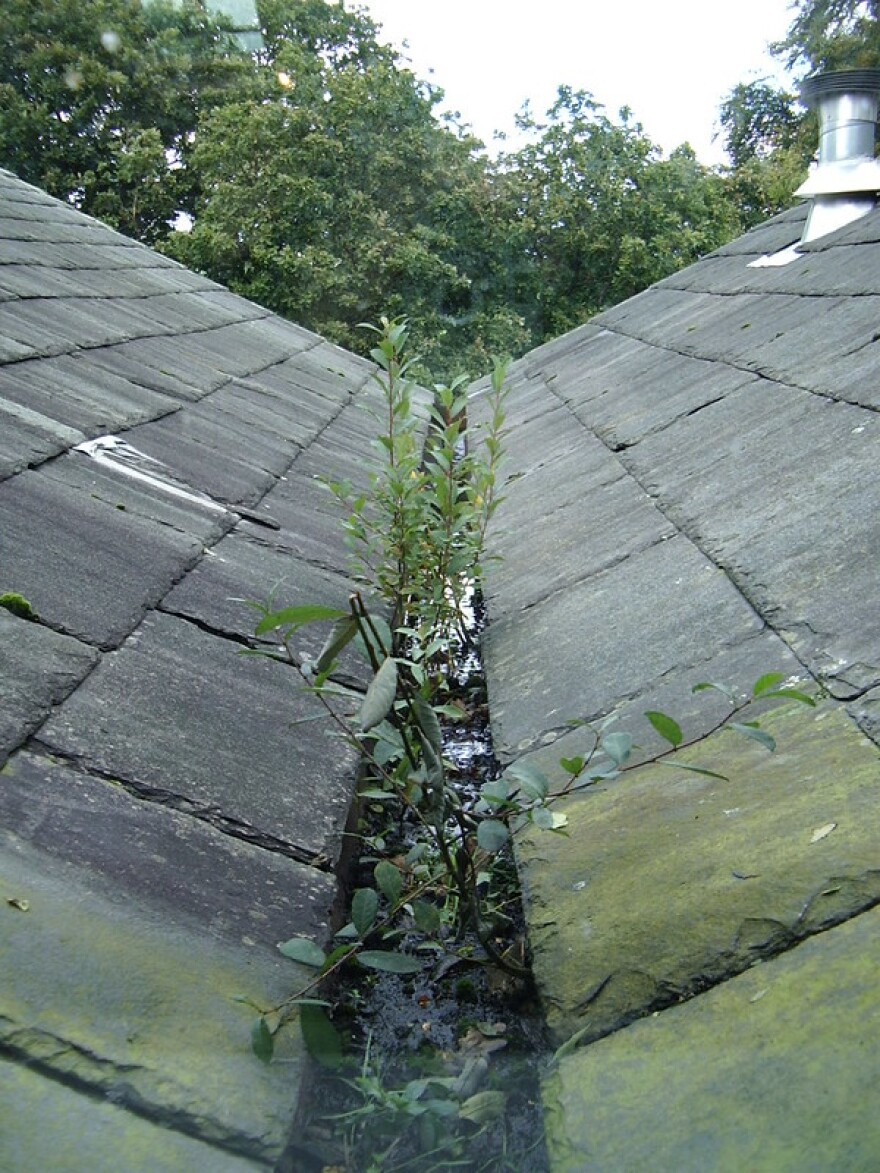In this edition of our occasional series 10X10, in which we take a close look at unusual or overlooked ecosystems, we’re getting our mind in the gutter.
Starting at the curb and working our way up, we spend this episode learning about which creatures take advantage of our waste-water systems; find evidence of extraterrestrial travel on our rooftops; and we look at how gutters function – or don’t – for the very species that designed them.
Editor's Note: This episode first aired in March of 2021.
10X10: City Gutters
Taylor Quimby
If you look at a detailed geographic map of streams and rivers, you might notice it looks a little like a roadmap. And in a way, it is. Rivers aren’t just homes for aquatic ecosystems. They’re highways for all sorts of animal life.
Human-engineered water systems, made up of culverts, sewers and pipes, function in the same way.
Ken Belt is a retired engineer and ecologist who worked for two decades in Baltimore’s Department of Public Works. He said that growing up in Baltimore, he’d be sitting on his front porch and out of nowhere, he’d see a possum.
“And we’d think, how did that thing get here? And it’s because they used the storm drains to get from here to there. Coyotes do the same thing. I would go into storm drains and I would find scat from raccoons. Hopefully they’re smart enough to get the hell out when they start hearing rumblings of flow.”
Ken said that gutters and storm drains aren’t just like streams - they are streams. Intermittent headwaters that can change suddenly from dry bed to raging river and back again.
In 2015, a team of researchers took to the streets of Paris to look for life in the gutters. They split up among the city's 20 districts, armed with equipment for collecting water, and toothbrushes for scraping up biofilms: microbial cities that form slimy carpets in and around the gutters.
They found 5,782 different OTUs, or Operational Taxonomic Units: genetic samples unique enough to operate as a loose surrogate for species -- so, basically, nearly 6,000 different kinds of microbes.
There was algae, photosynthesizing sunlight as it streamed into the city streets. Bacteria. A tiny, freshwater species of sponge. Fungi. A species of mollusk.
The gutters of Paris and other cities are home to an invisible biome, a complex ecosystem and food web. One that may be functioning a little like the one in wild streams: cleaning and filtering water, removing carbon from the air and producing oxygen.
Extreme Environments
Rooftop gutters, like the ones that line our curbs, are extreme environments: prone to bake in the sun one hot summer day, only to flush with water moments later during an afternoon storm.
But that’s only when they’re working. When gutters break or get clogged, they can become rich habitats.

Doug Hartman has owned Covenant Wildlife Management, based in Birmingham, Alabama, for 34 years. Throughout his career, he has seen it all. Gutters tend to operate like highways for small mammals like roof rats and squirrels.
“They go into the gutters because the gutter is like a feeding trough... it’s collecting any nuts and seeds that have fallen off the roof and collected in the gutter, and then you’ve got low spots that are collecting water in the gutter. And then they find that opening, getting into the soffit, they’ve got nice insulation they can use to stay warm, to stay dry. And all they’ve got to do is go onto their front porch and they’ve got food and water for them.”
It’s a domino effect. Once you’ve got nuts and leaves clogging your gutter, it’s only a matter of time before you’ll start a small forest.
“You’ll see pine trees growing out of gutters, oak trees,” Doug said.
And once you’ve got plants and mammals, next come predators like cats or snakes.
“So I’ve watched [snakes] crawl right up the side of a brick house and over the gutter and into the attic, and then I get into the attic and they’re up on a louvre vent chowing down on bats or something like that.”
Space Dust
A gutter is a product - and a receptacle, if you will - of its surroundings. It fills up with anything and everything that can fall or climb into it.
But the higher up, there isn’t much falling into the gutters of a city’s tallest buildings: just rain and snow, bird droppings, and wayward particles of pollution carried on the wind.
And one more thing: space dust, technically called ‘micro-meteorites.’
Micro-meteorites are miniature space rocks just two to three hundred microns across, a little bit smaller than the width of the human hair. Blown up, they look like otherworldly marbles, or the metallic shells of alien mollusks.
“Some micrometeorites melt as they come through the atmosphere because of the friction with the air as they come through, they enter the atmosphere at such high speeds they form tiny little droplets," said Matthew Genge, a planetary scientist at Imperial College in London.

Micrometeorites are both incredibly common but also exceedingly hard to locate. They fall constantly onto the surface of the earth at a rate of 6 particles per square meter per year. Unfortunately, those particles are mixed with millions of other particles of dust and pollution.
That’s why scientists who study micrometeorites tend to collect them in Antarctica, where they're easier to isolate. But one man was determined to find them in the chaos of the city.
“It all began when I got contacted by a chap called Jon Larsen,” Matthew said, “who told me he had been collecting micrometeorites on his roof.”
Jon Larsen, amateur astronomer, painter, and acclaimed jazz guitarist (he played with Chet Baker) was collecting grime from rooftops and rooftop gutters in search of dust from outer space.
Matthew was skeptical.
“In the end he sent me a photograph, and I thought, you know… that really does look like a micrometeorite. And it was.”
Today, Jon and Matthew have published a number of scientific articles, and Jon has released a book detailing how to find urban micrometeorites called “In Search of Stardust.”
The project has inspired hundreds of hobbyists around the world, who use magnets and microscopes to find extraterrestrial rocks just about anywhere.
Pollutants
Rain that falls in a forest may soak into the soil and slowly filter through the earth for days, years, millennia even, before popping out as a spring or seeping into the bed of a river.
But in a concrete waterway, everything is streamlined, integrated, and fast. And that means there is a lot of stuff being collected as water flows downstream.
Space dust, yes, but also salt, oil and antifreeze from vehicles leaking into roads, animal feces, fertilizer, and other pollutants and pharmaceuticals.
“They’re showing up in the water,” said Dr. Fushcia Hoover, a postdoc researcher at the National Socio-Environmental Synthesis Center in Annapolis, Maryland.
“Folks are trying to learn and discover what the impacts are on ecosystem health but also on human health."
In some cases, storm water runoff from gutters is being deposited directly into larger water bodies. But older cities — especially on the East Coast — often rely, in part, on combined systems that mix storm water with waste water.
In cases like these, all of that water and sewage flows into a treatment facility before being dumped back into the water cycle. But these systems were only built to handle so much flow. And because cities are home to more people, bigger storms, and more surface area than they were when the sewers were designed these systems have broken down.
Let’s use New York City as an example. When overloaded, combined sewer systems there dump overflow directly into places like the Bronx River, the East River, the Hudson, Coney Island Creek, and Jamaica Bay.
“You can kind of think of it like the extra drainage hole in your bathtub,” Dr. Hoover said. “Where the water is only allowed to get so high and then it starts running back into the drain so that you can't have an overflow event."
In 2016, New York City had 100 days where they dumped raw sewage directly into waterways. And this is happening in cities all over the United States every week, every month, every year.
[See a United States map of cities with Combined Sewer Systems.]
In areas where pipes are connected directly to storm water systems, rainfall can also lead to flooded streets and basements, leading to effluent exposure and health hazard risks in low-lying neighborhoods.
This is obviously a problem during events like Hurricane Katrina in 2005, but the harms aren’t reserved for occasional disasters. They’re regular; they’re getting more common; and they’re disproportionately affecting marginalized communities that historically have pushed into low-lying urban areas.
“Which is for me why it’s so important to think about storm water through an environmental justice lens,” Dr. Hoover said. “The challenge is being able to have systems that function the way that they should for everybody.”
The audio version of this story features Ken Belt, Carlos Goller, Menno Schilthuizen, Doug Hartman, Matthew Genge, Fushcia Hoover, and Joyce Hwang.
Stoner Panels
Sam Evans-Brown
There’s a legend among energy nerds.
It’s the kind of thing that is whispered to the new guy at the water cooler, “You want to know where this business really got its start?” It’s the sort of thing that, as a reporter, you hear over and over again.
According to this legend, California pot-growers — with their illicit capital and counter-cultural ideas — were instrumental in getting solar manufacturing off the ground, and without them, the industry as we know it would have withered on the vine.
So we set out to find out: where did this legend start, and is it true?
For more information about this episode, which first aried in January 2018, click here.









